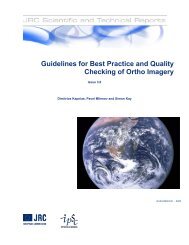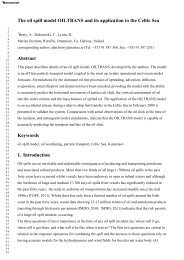Marine Industries Global Market Analysis - Marine Institute
Marine Industries Global Market Analysis - Marine Institute
Marine Industries Global Market Analysis - Marine Institute
You also want an ePaper? Increase the reach of your titles
YUMPU automatically turns print PDFs into web optimized ePapers that Google loves.
MARINE INDUSTRIES GLOBAL MARKET ANALYSIS<br />
77<br />
Major advances of the past decade have included the almost universal use of<br />
multibeam sonars as the primary tool for data gathering, differential global positioning<br />
(DGPS) as the primary navigation tool and use of advanced sonar data processing.<br />
Ocean survey technology is probably more likely to move forward in a process of<br />
incremental developments rather than by major breakthroughs. Examples of the<br />
former include the commercial application of synthetic array sonar (itself an old<br />
concept increasingly enabled by the improvements in underwater positioning) and the<br />
application of increasing amounts of processing power.<br />
In our view, major potential lies in the application of autonomous underwater vehicles<br />
(AUVs) to ocean survey. Long a tool of academia, outstanding results have been<br />
obtained in deepwater commercial operations in the Gulf of Mexico, off West Africa<br />
and the North Sea. However, the major challenge and indeed opportunity lies in<br />
applying the technology to increase survey efficiency in lesser water depths and attack<br />
the commercial dominance of the survey vessel as the conventional survey platform.<br />
11.6 THE LONG-TERM – 2010 ONWARDS<br />
Ongoing survey of the sea and oceans is a fundamental need for the establishment<br />
of governance mechanisms, continuance of world trade and the extraction of<br />
ocean resources.<br />
Increased awareness of the importance of the oceans to the overall environment is<br />
likely to increase spending on ocean survey.<br />
Much of the work carried out by countries’ hydrographic offices for the production<br />
of navigational charts is based on data gathered by naval survey vessels, a practice<br />
which is difficult to economically justify in a situation where such services can be<br />
bought more cheaply from commercial contractors. However, we expect that the<br />
economic argument will increasingly prevail.<br />
The growth ambitions of the main commercial contractors together with the fall-out<br />
resulting from business cycles has meant that rationalisation and consolidation<br />
activities have been extensive in the S&P market with one truly global player<br />
emerging (Fugro, Netherlands) and two mid size ones (C&C, US and Gardline, UK)<br />
together with a number of small, mainly national players.

















